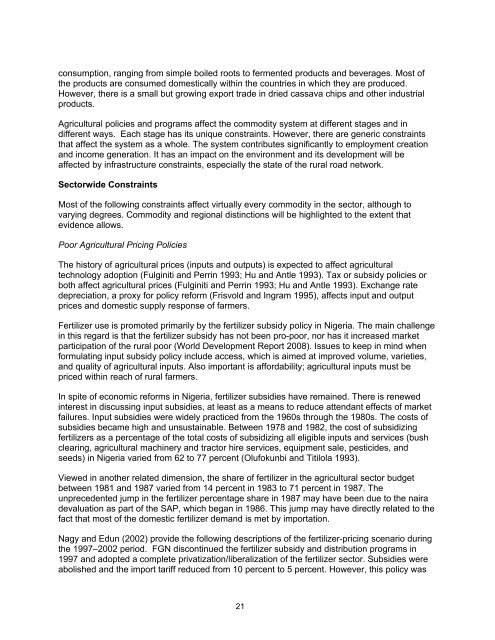Constraints to Increasing Agricultural Productivity in Nigeria: A Review
Constraints to Increasing Agricultural Productivity in Nigeria: A Review
Constraints to Increasing Agricultural Productivity in Nigeria: A Review
You also want an ePaper? Increase the reach of your titles
YUMPU automatically turns print PDFs into web optimized ePapers that Google loves.
consumption, rang<strong>in</strong>g from simple boiled roots <strong>to</strong> fermented products and beverages. Most of<br />
the products are consumed domestically with<strong>in</strong> the countries <strong>in</strong> which they are produced.<br />
However, there is a small but grow<strong>in</strong>g export trade <strong>in</strong> dried cassava chips and other <strong>in</strong>dustrial<br />
products.<br />
<strong>Agricultural</strong> policies and programs affect the commodity system at different stages and <strong>in</strong><br />
different ways. Each stage has its unique constra<strong>in</strong>ts. However, there are generic constra<strong>in</strong>ts<br />
that affect the system as a whole. The system contributes significantly <strong>to</strong> employment creation<br />
and <strong>in</strong>come generation. It has an impact on the environment and its development will be<br />
affected by <strong>in</strong>frastructure constra<strong>in</strong>ts, especially the state of the rural road network.<br />
Sec<strong>to</strong>rwide <strong>Constra<strong>in</strong>ts</strong><br />
Most of the follow<strong>in</strong>g constra<strong>in</strong>ts affect virtually every commodity <strong>in</strong> the sec<strong>to</strong>r, although <strong>to</strong><br />
vary<strong>in</strong>g degrees. Commodity and regional dist<strong>in</strong>ctions will be highlighted <strong>to</strong> the extent that<br />
evidence allows.<br />
Poor <strong>Agricultural</strong> Pric<strong>in</strong>g Policies<br />
The his<strong>to</strong>ry of agricultural prices (<strong>in</strong>puts and outputs) is expected <strong>to</strong> affect agricultural<br />
technology adoption (Fulg<strong>in</strong>iti and Perr<strong>in</strong> 1993; Hu and Antle 1993). Tax or subsidy policies or<br />
both affect agricultural prices (Fulg<strong>in</strong>iti and Perr<strong>in</strong> 1993; Hu and Antle 1993). Exchange rate<br />
depreciation, a proxy for policy reform (Frisvold and Ingram 1995), affects <strong>in</strong>put and output<br />
prices and domestic supply response of farmers.<br />
Fertilizer use is promoted primarily by the fertilizer subsidy policy <strong>in</strong> <strong>Nigeria</strong>. The ma<strong>in</strong> challenge<br />
<strong>in</strong> this regard is that the fertilizer subsidy has not been pro-poor, nor has it <strong>in</strong>creased market<br />
participation of the rural poor (World Development Report 2008). Issues <strong>to</strong> keep <strong>in</strong> m<strong>in</strong>d when<br />
formulat<strong>in</strong>g <strong>in</strong>put subsidy policy <strong>in</strong>clude access, which is aimed at improved volume, varieties,<br />
and quality of agricultural <strong>in</strong>puts. Also important is affordability; agricultural <strong>in</strong>puts must be<br />
priced with<strong>in</strong> reach of rural farmers.<br />
In spite of economic reforms <strong>in</strong> <strong>Nigeria</strong>, fertilizer subsidies have rema<strong>in</strong>ed. There is renewed<br />
<strong>in</strong>terest <strong>in</strong> discuss<strong>in</strong>g <strong>in</strong>put subsidies, at least as a means <strong>to</strong> reduce attendant effects of market<br />
failures. Input subsidies were widely practiced from the 1960s through the 1980s. The costs of<br />
subsidies became high and unsusta<strong>in</strong>able. Between 1978 and 1982, the cost of subsidiz<strong>in</strong>g<br />
fertilizers as a percentage of the <strong>to</strong>tal costs of subsidiz<strong>in</strong>g all eligible <strong>in</strong>puts and services (bush<br />
clear<strong>in</strong>g, agricultural mach<strong>in</strong>ery and trac<strong>to</strong>r hire services, equipment sale, pesticides, and<br />
seeds) <strong>in</strong> <strong>Nigeria</strong> varied from 62 <strong>to</strong> 77 percent (Olufokunbi and Titilola 1993).<br />
Viewed <strong>in</strong> another related dimension, the share of fertilizer <strong>in</strong> the agricultural sec<strong>to</strong>r budget<br />
between 1981 and 1987 varied from 14 percent <strong>in</strong> 1983 <strong>to</strong> 71 percent <strong>in</strong> 1987. The<br />
unprecedented jump <strong>in</strong> the fertilizer percentage share <strong>in</strong> 1987 may have been due <strong>to</strong> the naira<br />
devaluation as part of the SAP, which began <strong>in</strong> 1986. This jump may have directly related <strong>to</strong> the<br />
fact that most of the domestic fertilizer demand is met by importation.<br />
Nagy and Edun (2002) provide the follow<strong>in</strong>g descriptions of the fertilizer-pric<strong>in</strong>g scenario dur<strong>in</strong>g<br />
the 1997–2002 period. FGN discont<strong>in</strong>ued the fertilizer subsidy and distribution programs <strong>in</strong><br />
1997 and adopted a complete privatization/liberalization of the fertilizer sec<strong>to</strong>r. Subsidies were<br />
abolished and the import tariff reduced from 10 percent <strong>to</strong> 5 percent. However, this policy was<br />
21
















